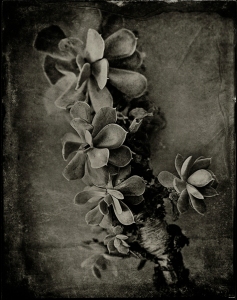Art: the Slave of Inspiration
“We delight in the beauty of the butterfly, but rarely admit the changes it has gone through to achieve that beauty.”
In interviewing both artists whose joint show opens this Thursday at the Rebekah Jacob Gallery in Charleston, it struck me how seriously Tom Nakashima and Gary Geboy take inspiration. I’m not talking about the refrigerator magnet affirmation kind of inspiration, but the demanding mistress kind that compels them both to create.
That light bulb moment most of us imagine as how artists “get” inspired — the way the light hits a pile of upended trees or the delicate symmetry of the veins in a single crinkled leaf – that’s the natural, organic part for Nakashima and Geboy. Art is how they make sense of the world around them but transforming that inspiration into paintings and photographs requires less mysterious tools.
For Nakashima, the tool is often a photograph he makes to capture the textures, details and compositional possibilities of an image. Here’s an example he shared with me for the upcoming “Organic Legacies” show:


Other times, inspiration demands that he build a still life to begin the process of transformation.


“Any fool can be happy. It takes a man with real heart to make beauty out of the stuff that makes us weep.”
― Clive Barker, Days of Magic, Nights of War
Nakashima’s Treepile series got its start with a chance encounter: a huge mound of trunks and tree limbs near rural Berryville, VA. “He begins with nature – piles of dead branches silhouetted against the ground or sky,” wrote Joann Moser, Senior Curator at the Smithsonian American Art Museum, “and transforms them into monumental compositions redolent with meaning.”
For Geboy, the tools of inspiration include the camera and the negative itself – simply starting points for the image he sets out to create. For one collection he took digital snapshots of a different kind of still life: a museum diorama.


For some of work debuting Thursday, he’s framed both the wet glass plate collodion negatives and the final image for patrons to literally see behind the scenes.


“You might not recognize the process by name, but if you’ve ever looked at Civil War images by Matthew Brady’s photographers you’ve seen wet glass plate collodion,” says Rebekah Jacob, gallery owner and southern art historian. “Gary breathes new life into a forgotten process and preserves a part of the South that is truly universal.”


“Art is the lie that enables us to realize the truth.”
Where other photographers spend thousands of dollars on lenses and cameras, Geboy often shoots with a $20 plastic Holga. Nakashima says his favorite canvass is actually news rag.
“I really don’t have a favorite piece of equipment,” says Geboy. “Each camera I use has a specific purpose and frankly if I could get what’s in my head on a piece of paper without a camera, I’d be a happy guy.”
It’s not surprising, then, that neither artist is fussy about discussing their technique. They know it’s just a tool for expressing something only they can see.
“One eye sees, the other feels.”
For more information about Tom Nakashima and Gary Geboy’s exhibit, which opens Thursday, February 12th, visit the Rebekah Jacob Gallery website.
February 9, 2015 at 11:00 AM
Reblogged this on TeresaBruceBooks' "Right Brain Safari" and commented:
Which comes first, the art or the inspiration?
LikeLike